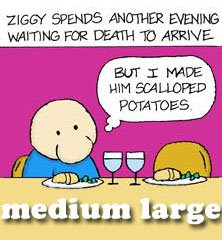One must admire or at least marvel at the hard road upon which the artist is willing to embark. A road fraught with dead end pursuits, potholes of misfortune and the burst sewer main pipe of success. A road that more often than not leads to melancholy, misery and marketing. A road that probably features more Arby’s than prospects. And it is not uncommon in the middle of such a dark, despairing journey that one turns to a higher power for guidance and reassurance. That one looks to the spiritual when the material has failed them. That one takes that quick detour to religious salvation. But being creative you wouldn’t simply want to co-op an existing faith. Of course not! You’d want to create your own church.
That’s when it’s time to use your God-given talents to give others a new take of God. But before you start penning parables, designing vestments and founding a limited liability company excused of all tax obligations, best to research how others have established their own church before you. This can be done by either acquiring a Masters degree in religion studies or by getting the quick gist of a four-page evangelical pamphlet discarded on a street corner with the rather pithy yet profound title of "Earthquake."
Written by one Tony Alamo, self-proclaimed (and one suspects self-ordained) "World Minister" of Tony Alamo Christian Ministries, the pamphlet attempts to show the correlation between several Old Testament prophecies (read: threats) and a recent natural disaster. By "recent," of course, I mean the Los Angeles earthquake of January 17, 1994.
Now, why Minister Tony is a more than a decade off on his calamities is anyone's guess (mine is it took him a good ten years to scrape up the money to buy the MacWord program used to format the pamphlet). But that in no way means Tony is not an artist. In fact, his pamphlet could very well serve as the definitive template for all creative individuals who have given up on their craft but not their need for an audience. Just by opening the pious flyer one is immediately struck by how quickly Tony piques his reader’s interest, employing such attention-catching phrases as:
"Several Bible scriptures tell us that EARTHQUAKES are one of God's many instruments of judgment."
"Los Angeles is more sinful and more guilty than the other reprobate cities of the world."
"God is mankind's worst enemy."
Clearly Tony is a firm believer of the Old Testament (or "Old School") God, the deity who would rather put millions in peril than let the entertainment industry make a third sequel to Major League. But, alas, proclamations alone do not make for a gripping tale. Like many an accomplished artist, Minister Tony knows that to sell a story it must be set in a specific time and place. It must also provide a definite point of view so that the reader can locate themselves within the context of the action and never feel lost or confused by ensuing events. These are the hallmarks of great writing and Tony achieves these with perfect economic skill, as evident in his opening sentence:
"Thursday, January 13, 1994 I was in Los Angeles for a court appearance."
Almost instantly the reader is given both an entrance into the story as well as a desire to know more, such as "What possible good reason could a district attorney have to call in a minister of a religious organization named after said minister?" But Tony realizes that great storytelling is as much as about what you withhold as what you reveal, and so with his second sentence he chooses not to clarify so much as deepen the mystery:
"Three days later, Sunday, January 16, 1994, I was inspired again by the Lord to leave Los Angeles without delay."
Once again, the reader is left wanting for information, such as what possible reason would a man charged with a crime suddenly decide to skip town? (And why has he clearly done such before?) But rather than simply satiate his audience's desire, Tony wisely opts to play on its empathetic nature in the very next line:
"Everyone was disappointed because our original plans were to spend the afternoon at the sunny beach in Venice."
And so in three short sentences, Tony has given us a setting, an action and a reason to mourn over missed opportunities. In fact, the only thing he hasn't given us is something to do with earthquakes, the bible or a reason for why he used three different fonts in the same pamphlet. But that's what those in the writing biz call "baiting the hook," and as disaster finally rocks L.A. Tony reels us in with one startling statement after another:
"God's wisdom for our leaving Los Angeles and moving our services to a motel in Phoenix was now made known to us."
"California has always been the pilot state or testing ground in North America for one-world government tyranny and stupidity. Now God is using this state as a sort of sneak preview of His coming attractions."
"We travel by car and generally never stop, except for fuel and food."
So the with each page the reasons behind Tony's story are slowly made known to us: Tony has a friend in God. Tony's court appearance has obviously given him a less than kind perspective on California state law. Tony doesn’t quite realize that “sneak preview” and “coming attractions” are pretty much the same thing. Tony drives like a man on a mission or on the lam.
But in the end the reader still does not know learn the true meaning of his tale. We still do not know why he felt so compelled to not only write his magnum opus but then take a full decade to edit it. Was it to warn us sinners to quickly change our ways before it's too late? Perhaps. Was it to tell us we are best to alter our flight plans? Possibly. Was it to play off recent mounting fears about everything without having to go through all the needless trouble of revising a hastily put-together newsletter from 1994? Probably. Tony leaves us wanting more, actually begging for more, and that, my friends, is the stamp of a truly inspirational artist.
Subscribe to:
Post Comments (Atom)







1 comment:
Amen!
Post a Comment